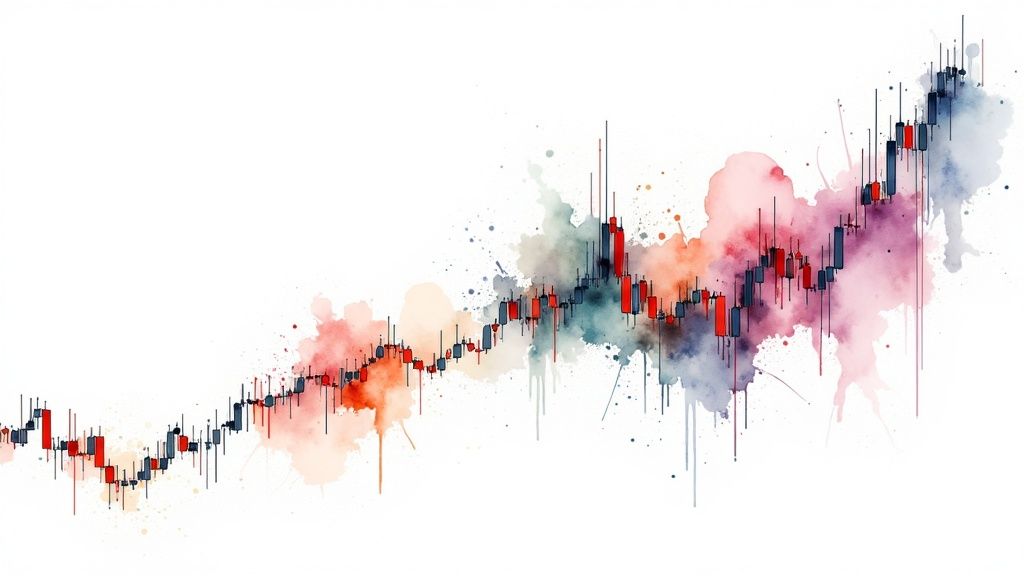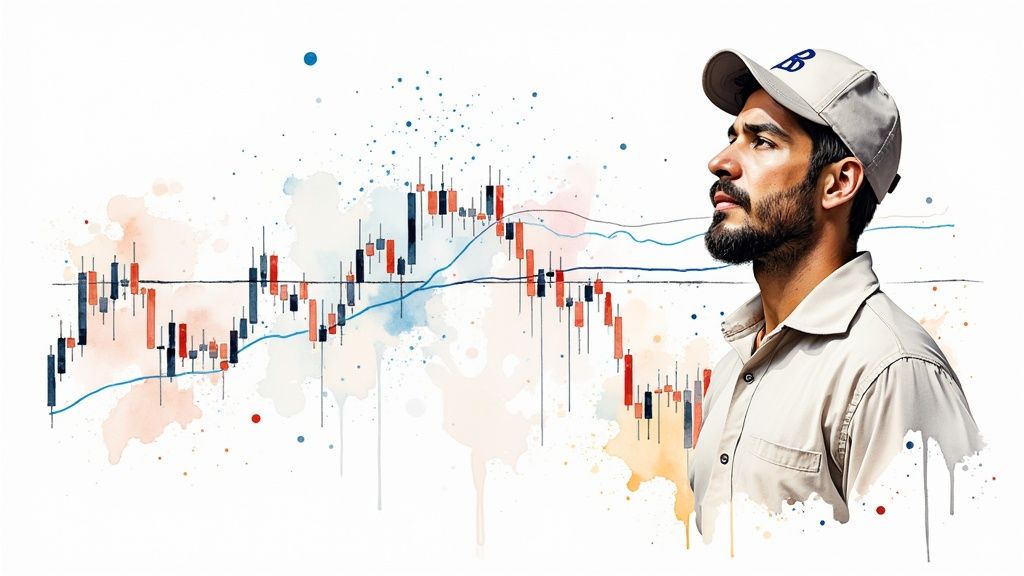




Reading crypto charts requires understanding several key components that form the foundation of technical analysis. The timeframe selection is essential - it determines how each price point is represented. Day traders often analyze 1-minute or 1-hour charts, while investors may prefer daily or weekly views. Your chosen timeframe should align with your specific trading strategy and goals.
The candlestick pattern provides crucial price data through visual elements. Each candle shows the opening, closing, high, and low prices within a set period. A green candle signals price growth, while a red candle indicates decline. These patterns often cluster into recognizable formations that can suggest future price movements and market sentiment.
Traders commonly use Japanese Candlestick charts to analyze market movements. The Hammer Candle Pattern exemplifies a bullish reversal signal, featuring a short body and long lower wick that suggests strong buying pressure. For valid trading signals, confirm these patterns by checking subsequent price action and trading volume. Learn more about chart analysis here.
Support and resistance levels mark key price points where market psychology shifts. Support represents a price floor where buying typically increases, while resistance acts as a ceiling where selling often intensifies. These levels emerge from historical price action and help traders identify potential entry and exit points for trades.
Volume measures trading activity and helps confirm price moves. Strong volume backing a price trend suggests conviction, while weak volume may indicate an unstable move. For example, when prices break through resistance with high volume, it often signals a genuine breakout rather than a false move. Understanding these basic elements enables more effective chart analysis and trading decisions.
Reading crypto charts requires a deep understanding of historical data to spot trends and cycles that shape trading decisions. By studying past price movements, volume data, and key market events, traders can build a stronger foundation for predicting future market behavior.
Like traditional markets, cryptocurrencies move through distinct growth and decline phases called market cycles. These cycles show peaks and troughs across different timeframes. Understanding these rhythmic movements helps traders spot potential market turning points. For example, when prices consolidate after a sharp rise, it may signal an upcoming reversal.
Previous price action reveals critical support and resistance levels where markets tend to pause or reverse direction. These historical price points help traders predict where buying or selling pressure might emerge, enabling more precise entry and exit points for trades.
Charts display recurring patterns like head and shoulders or double tops and bottoms that provide trading signals. Studying how these formations played out historically helps traders spot and act on similar setups. Consider Ethereum's price journey - from $7 in December 2016 to $700 in December 2017, then down to $3,100 by December 2018. Bitcoin followed a similar path, moving from $800 to $20,000 before declining. Check more historical data on CoinMarketCap.
While past data provides valuable context, it cannot guarantee future outcomes. Smart traders blend historical analysis with real-time market observation and technical indicators for a complete view. This balanced approach, considering both past patterns and present conditions, helps create more effective trading strategies in the volatile crypto markets.

Beyond basic chart patterns and historical data analysis, market indicators provide powerful tools for analyzing crypto markets. These technical analysis tools reveal insights about momentum, trends, and potential price reversals. When used effectively, they help traders make data-driven decisions with greater confidence.
Key technical indicators that form the foundation of crypto chart analysis include:
Relative Strength Index (RSI): This popular momentum indicator measures price change velocity. An RSI reading above 70 typically indicates overbought conditions where prices may pull back. Readings below 30 suggest oversold conditions that could lead to rebounds.
Moving Average Convergence Divergence (MACD): By showing the relationship between two moving price averages, MACD helps identify shifts in trend strength, direction and momentum. The indicator consists of converging and diverging lines that signal potential entry and exit points.
Moving Averages: These smooth out price action over set time periods to reveal underlying trends. Common intervals include the 50-day, 100-day, and 200-day moving averages. Price interactions with these lines often mark key support and resistance zones.
Experienced traders rarely rely on single indicators in isolation. Instead, they look for confirmation across multiple indicators to validate trading signals. For example, an RSI moving out of oversold territory combined with a bullish MACD crossover provides stronger evidence of an upward trend compared to either signal alone.
Market conditions heavily influence how indicators should be interpreted. During high volatility periods, indicators like RSI may frequently reach extreme levels without necessarily signaling viable trades. The crypto market reached $910.3 million in 2021 and projects to hit $1,902.5 million by 2028, growing at 11.1% CAGR according to research from Fortune Business Insights. This rapid growth creates dynamic conditions requiring flexible analysis approaches.
By mastering key indicators, you can build a personalized trading approach aligned with your goals and risk tolerance. Focus on testing strategies with historical data, optimizing indicator settings through experience, and continuously refining your methods based on results. Moving from reactive to anticipatory trading gives you an edge in navigating crypto markets effectively.
Success in cryptocurrency trading requires going beyond basic chart analysis. By learning advanced pattern recognition strategies, traders can spot potential market movements before they happen - a valuable skill in the fast-moving crypto markets.
The following patterns have proven reliable for predicting price movements:
The Fibonacci sequence generates key price levels that often act as support and resistance. The most important Fibonacci retracement levels are 23.6%, 38.2%, and 61.8% - these frequently mark where price pullbacks end before the trend continues. For projecting price targets after breakouts, traders use Fibonacci extensions like 127.2% and 161.8%. Learning to spot these levels helps identify optimal trade entry and exit points.
Pattern recognition works best when confirmed by other technical indicators. For example, if you see a head and shoulders pattern forming, check if the RSI or MACD also shows bearish signals - this adds confidence to the trade setup. Trading volume provides another key confirmation signal - high volume on pattern breakouts suggests strong momentum that's likely to continue. Using multiple technical tools together helps filter out false signals and identify high-probability trading opportunities. With practice, you'll develop an eye for spotting these patterns early, leading to better trade timing and results. Remember that no pattern works 100% of the time - always use proper risk management regardless of how clear the setup appears.

The ability to read crypto charts depends heavily on understanding how trading volume, price action, and market sentiment interact. These key elements provide vital information about market dynamics and help traders make more informed decisions. Volume analysis adds essential context to price movements, helping verify the strength of market trends and potential turning points.
Volume serves as a critical indicator for confirming price trends. When prices rise with increasing volume, it shows strong bullish momentum and buyer conviction. However, rising prices with falling volume often warn of a weakening trend. These divergences between price and volume frequently signal upcoming price reversals.
Major volume spikes often signal possible trend changes. A sudden surge in volume during a price drop may indicate a capitulation event, where sellers panic and exit positions en masse. These events can mark the end of downtrends and create buying opportunities. Similar high-volume events at price peaks may signal market tops.
Volume data offers key insights into overall market health. Steady high volume across multiple cryptocurrencies typically indicates an active, robust market. In contrast, persistently low volume can point to waning interest and suggest sideways or declining prices. This helps traders time their entries and exits more effectively.
Large volume movements may reveal institutional activity as major investors build or liquidate positions. While not always obvious, these substantial trades can significantly impact market direction. Learning to spot potential institutional moves requires careful analysis of volume patterns alongside other indicators.
High volume doesn't always reflect genuine market activity. Wash trading involves artificially inflating volume through coordinated trading to create false impressions of market strength. Watch for unexplained volume spikes without corresponding price moves as potential manipulation red flags. Read also: How to Master Cryptocurrency Sentiment Analysis.
Building volume analysis into your trading approach helps make more informed decisions. By confirming trends, identifying reversals, measuring market strength, and detecting manipulation, you can better interpret crypto charts. Combining volume analysis with technical indicators like RSI and MACD creates a more complete trading approach.

Reading crypto charts is just the beginning. To make real profits, you need to create and execute well-structured trading plans. This requires a methodical process to convert chart analysis into profitable trades.
A clear trading plan serves as your guide in crypto markets. It outlines how you'll enter and exit trades, manage risk, and work toward your investment targets. Having this framework helps maintain rational decision-making during market swings.
Position sizing determines your capital allocation per trade. Smart sizing limits the impact of losses and protects your funds. Stop-losses and other risk tools are critical safeguards.
Effective execution means entering and exiting trades precisely at your planned prices. Good management involves watching open positions and adapting as markets shift.
Successful traders use multiple analysis methods together for better results:
No single strategy works for everyone. Build an approach that matches your goals and risk comfort level. Focus on ongoing learning, adaptation, and disciplined execution.
By following these principles to create structured trading plans, you can turn chart analysis into consistent profits. Take your trading further with Coindive, a complete crypto community and market analysis platform for data-driven decisions. Start using Coindive to improve your crypto trading results.